Unraveling Socio-Ecological Inequities in Outer London: Cluster-Based Resilience Planning
Abstract
1. Introduction
- (1)
- How to construct CSEI and RSEI and systematically incorporate them into the framework of social ecological inequity?
- (2)
- What is the spatial pattern of social and ecological inequity in Outer London? How do these patterns interact in the peri-urban environment?
- (3)
- What is the internal mechanism of the social–ecological coupling type?
- (4)
- How do multi-scale governance approaches correspond to different types of spatial coupling?
2. Methods
2.1. Study Area
2.2. Research Flow
2.3. Indicator Framework and Construction Rationale
2.3.1. Independent Variables: Composite Social Equity Index
2.3.2. Dependent Variables: Remote Sensing Ecological Index (RSEI)
2.4. Spatial Cluster Analysis
2.5. Ordinary Least Squares (OLS)
2.6. MGWR Analysis
3. Results
3.1. Results of Spearman Correlation
3.2. The RSEI of Outer London
3.3. The Relationships and the Spatial Disparities Between CSEI and RSEI
3.4. OLS Result
3.5. Spatial Agglomeration Analysis
3.6. Model Comparison
4. Discussion
4.1. Differentiated Drivers of Socio-Ecological Patterns
4.2. Unequal Green: Ecological Recovery Amid Social Decline
4.3. Multi-Scale Interpretation and Governance Implications of MGWR
4.3.1. Macro Driving Factors
4.3.2. Micro Driving Factors
4.3.3. Multi-Scale Governance Strategy
4.4. Global Comparison and International Significance
4.5. Limitations and Future Research
5. Conclusions
Author Contributions
Funding
Data Availability Statement
Conflicts of Interest
Abbreviations
| CSEI | Comprehensive Social Equity Index |
| RSEI | Remote Sensing Ecological Index |
| EWM | Entropy Weighting Method |
| PCA | Principal Component Analysis |
| OLS | Ordinary Least Squares |
| MGWR | Multi-scale Geographically Weighted Regression |
| GWR | Geographically Weighted Regression |
| NDVI | Normalized Difference Vegetation Index |
| LST | Land surface temperature |
| IBI | Index-based Built-up Index |
| SI | Soil Index |
Appendix A
| Indicators | Formula | Description | Explanation |
|---|---|---|---|
| Greenness | Normalized Difference Vegetation Index (NDVI) is used to measure the state of vegetation. Higher NDVI values indicate denser, healthier plant cover. | where represent Landsat 8 OLI/TIRS bands, respectively [44]. | |
| Wet | The wet index is closely related to the humidity of vegetation and soil, and its value is used to reflect the humidity status in the study area. | where represent Landsat 8 OLI/TIRS bands, respectively. are the calculation coefficient of the humidity component in the K-T transformation of different types of Landsat data [91]. | |
| Heat | Land surface temperature (LST) is used to represent heat. | where is the brightness temperature, is the band central wavelength, h is the Planck’s constant (), c is the velocity of light (2.998 × 108 m/s) and k is the Boltzmann constant () [92]. | |
| Dryness | The dryness index is expressed using the NDBSI, which is combination of the Index-based Built-up Index (IBI) and the soil index (SI). | where represent the bands of the remote sensing image [44]. |
Appendix B
| Indicators | Formula | Explanation |
| OLS | where is the dependent variable (RSEI); represents the intercept term; is the estimated coefficients; represents the array of independent variables (Socio-economic index), and is the error term [57]. | |
| MGWR | where represents the dependent variable (RSEI); is the values of the -th independent variable (Socio economic index); are the local regression coefficients for the -th is the explanatory variable (Socio economic index) at location [57]. |
References
- Görg, C.; Brand, U.; Haberl, H.; Hummel, D.; Jahn, T.; Liehr, S. Challenges for Social-Ecological Transformations: Contributions from Social and Political Ecology. Sustainability 2017, 9, 1045. [Google Scholar] [CrossRef]
- Wu, J. Urban Ecology and Sustainability: The State-of-the-Science and Future Directions. Landsc. Urban Plan. 2014, 125, 209–221. [Google Scholar] [CrossRef]
- Venter, Z.S.; Figari, H.; Krange, O.; Gundersen, V. Environmental Justice in a Very Green City: Spatial Inequality in Exposure to Urban Nature, Air Pollution and Heat in Oslo, Norway. Sci. Total Environ. 2023, 858, 160193. [Google Scholar] [CrossRef]
- Wolch, J.R. Urban Green Space, Public Health, and Environmental Justice: The Challenge of Making Cities ‘Just Green Enough’. Landsc. Urban Plan. 2014, 125, 234–244. [Google Scholar] [CrossRef]
- Xu, Z.; Lin, Z.; Wang, L.; Shang, Z.; Sun, C. Spatial Planning Interventions for Winter Sunbathing: Optimizing Neighborhood Open Spaces for the Elderly in Jiande, China. Front. Archit. Res. 2025. [Google Scholar] [CrossRef]
- Bullard, R.D. Ecological Inequities and the New South: Black Communities under Siege. J. Ethn. Stud. 1990, 17, 101. [Google Scholar]
- Islam, M.S. Rethinking Climate Justice: Insights from Environmental Sociology. Climate 2024, 12, 203. [Google Scholar] [CrossRef]
- Sharma-Wallace, L. Toward an Environmental Justice of the Rural-Urban Interface. Geoforum 2016, 77, 174–177. [Google Scholar] [CrossRef]
- Nilsson, K.; Pauleit, S.; Bell, S.; Aalbers, C.; Nielsen, T.A.S. Peri-Urban Futures: Scenarios and Models for Land Use Change in Europe; Springer Science & Business Media: Berlin/Heidelberg, Germany, 2013; ISBN 3-642-30529-6. [Google Scholar]
- Gant, R.L.; Robinson, G.M.; Fazal, S. Land-Use Change in the ‘Edgelands’: Policies and Pressures in London’s Rural–Urban Fringe. Land Use Policy 2011, 28, 266–279. [Google Scholar] [CrossRef]
- Kendall, E. An Economic Analysis of the Contribution of Health Care to Health Inequality. Ph.D. Thesis, University College London, London, UK, 2014. [Google Scholar]
- Liu, S.; Qi, J.; Yang, Y.; Huo, W.; Li, J.; Chang, Y.; Peng, Y. Deconstructing Urban Green Justice and Well-Being: A Multi-Group Structural Equation Modeling Analysis Based on the Activity Space Perspective. Front. Public Health 2025, 13, 1670454. [Google Scholar] [CrossRef]
- Buss, T.F.; Ahmed, U. Social Equity and Development; Routledge: Oxfordshire, UK, 2015; pp. 78–97. [Google Scholar]
- Pellow, D.N.; Weinberg, A.; Schnaiberg, A. The Environmental Justice Movement: Equitable Allocation of the Costs and Benefits of Environmental Management Outcomes. Soc. Justice Res. 2002, 14, 423–439. [Google Scholar] [CrossRef]
- Paetzold, A.; Warren, P.H.; Maltby, L.L. A Framework for Assessing Ecological Quality Based on Ecosystem Services. Ecol. Complex. 2010, 7, 273–281. [Google Scholar] [CrossRef]
- Gui-Rui, Y.; Yong-sheng, W.; Meng, Y. Discussion on the Ecological Theory and Assessment Methods of Ecosystem Quality and Its Evolution. Chin. J. Appl. Ecol. Shengtai Xuebao 2022, 33, 865–877. [Google Scholar]
- Bedi, C.; Kansal, A.; Mukheibir, P. A Conceptual Framework for the Assessment of and the Transition to Liveable, Sustainable and Equitable Cities. Environ. Sci. Policy 2023, 140, 134–145. [Google Scholar] [CrossRef]
- Martínez-Bravo, M.D.M.; Martínez-del-Río, J.; Antolín-López, R. Trade-Offs among Urban Sustainability, Pollution and Livability in European Cities. J. Clean. Prod. 2019, 224, 651–660. [Google Scholar] [CrossRef]
- Whiteley, T.D.; Avitabile, D.; Siebers, P.-O.; Robinson, D.; Owen, M.R. Modelling the Emergence of Cities and Urban Patterning Using Coupled Integro-Differential Equations. J. R. Soc. Interface 2022, 19, 20220176. [Google Scholar] [CrossRef]
- Salvia, R.; Halbac-Cotoara-Zamfir, R.; Cividino, S.; Salvati, L.; Quaranta, G. From Rural Spaces to Peri-Urban Districts: Metropolitan Growth, Sparse Settlements and Demographic Dynamics in a Mediterranean Region. Land 2020, 9, 200. [Google Scholar] [CrossRef]
- Sahana, M.; Ravetz, J.; Patel, P.P.; Dadashpoor, H.; Follmann, A. Where Is the Peri-Urban? A Systematic Review of Peri-Urban Research and Approaches for Its Identification and Demarcation Worldwide. Remote Sens. 2023, 15, 1316. [Google Scholar] [CrossRef]
- Zhang, Y. Urban Morphology and Ecosystem Services: A Historico-Geographical Study of Fringe Belts and Urban Green Spaces in Birmingham, UK. Ph.D. Thesis, University of Birmingham, Birmingham, UK, 2018. [Google Scholar]
- Orford, S. Identifying and Comparing Changes in the Spatial Concentrations of Urban Poverty and Affluence: A Case Study of Inner London. Comput. Environ. Urban Syst. 2004, 28, 701–717. [Google Scholar] [CrossRef]
- La Rosa, D.; Geneletti, D.; Spyra, M.; Albert, C.; Fürst, C. Sustainable Planning for Peri-Urban Landscapes. In Ecosystem Services from Forest Landscapes: Broadscale Considerations; Perera, A.H., Peterson, U., Pastur, G.M., Iverson, L.R., Eds.; Springer International Publishing: Cham, Switzerland, 2018; pp. 89–126. ISBN 978-3-319-74515-2. [Google Scholar]
- Grant, U. Spatial Inequality and Urban Poverty Traps; Overseas Development Institute: London, UK, 2010. [Google Scholar]
- Available online: https://www.ons.gov.uk/ (accessed on 6 May 2025).
- Available online: https://www.ordnancesurvey.co.uk/ (accessed on 1 October 2023).
- Available online: https://earthexplorer.usgs.gov/ (accessed on 6 May 2025).
- Kiely, E.; Strong, S. The Indexification of Poverty: The Covert Politics of Small-Area Indices. Antipode 2023, 55, 1758–1780. [Google Scholar] [CrossRef]
- Available online: https://www.gov.uk/government/publications/social-mobility-commission-business-plan-2022-to-2023-a-fresh-approach-to-social-mobility/social-mobility-commission-business-plan-2022-to-2023-a-fresh-approach-to-social-mobility (accessed on 6 May 2025).
- Kivinen, O.; Ahola, S. Higher Education as Human Risk Capital. High. Educ. 1999, 38, 191–208. [Google Scholar] [CrossRef]
- Ryan-Collins, J. The Demand for Housing as an Investment: Drivers, Outcomes and Policy Interventions to Enhance Housing Affordability in the UK; UCL Institute for Innovation and Public Purpose (IIPP): London, UK, 2024. [Google Scholar]
- McGowan, V.J.; Akhter, N.; Halliday, E.; Popay, J.; Kasim, A.; Bambra, C. Collective Control, Social Cohesion and Health and Well-Being: Baseline Survey Results from the Communities in Control Study in England. J. Public Health 2022, 44, 378–386. [Google Scholar] [CrossRef] [PubMed]
- Chen, S.; Sun, Y.; Seo, B.K. The Effects of Public Open Space on Older People’s Well-Being: From Neighborhood Social Cohesion to Place Dependence. Int. J. Environ. Res. Public Health 2022, 19, 16170. [Google Scholar] [CrossRef] [PubMed]
- Boswell, J.; Denham, J.; Furlong, J.; Killick, A.; Ndugga, P.; Rek, B.; Ryan, M.; Shipp, J. Place-Based Politics and Nested Deprivation in the U.K.: Beyond Cities-Towns, ‘Two Englands’ and the ‘Left Behind’. Representation 2022, 58, 169–190. [Google Scholar] [CrossRef]
- Syrbe, R.-U.; Walz, U. Spatial Indicators for the Assessment of Ecosystem Services: Providing, Benefiting and Connecting Areas and Landscape Metrics. Ecol. Indic. 2012, 21, 80–88. [Google Scholar] [CrossRef]
- Nesbitt, L.; Meitner, M.J.; Girling, C.; Sheppard, S.R.J.; Lu, Y. Who Has Access to Urban Vegetation? A Spatial Analysis of Distributional Green Equity in 10 US Cities. Landsc. Urban Plan. 2019, 181, 51–79. [Google Scholar] [CrossRef]
- Grossi, A.A.; Randhawa, G.; Jansen, N.E.; Paredes-Zapata, D. Taking a “Care Pathway/Whole Systems” Approach to Equality Diversity Inclusion (EDI) in Organ Donation and Transplantation in Relation to the Needs of “Ethnic/Racial/Migrant” Minority Communities: A Statement and a Call for Action. Transpl. Int. 2023, 36, 11310. [Google Scholar] [CrossRef]
- Pinto-Coelho, J.M.; Zuberi, T. Segregated Diversity. Sociol. Race Ethn. 2015, 1, 475–489. [Google Scholar] [CrossRef]
- Wu, C.; Ye, Y.; Gao, F.; Ye, X. Using Street View Images to Examine the Association between Human Perceptions of Locale and Urban Vitality in Shenzhen, China. Sustain. Cities Soc. 2023, 88, 104291. [Google Scholar] [CrossRef]
- Mazziotta, M.; Pareto, A. Principal Component Analysis for Constructing Socio-Economic Composite Indicators: Theoretical and Empirical Considerations. SN Soc. Sci. 2024, 4, 114. [Google Scholar] [CrossRef]
- Zhen, B.; Dang, G.; Zhu, L. Spatio-Temporal Changes and Driving Forces of Ecological Environment Quality in Northern China from 2000 to 2022. J. Geogr. Sci. 2025, 35, 763–782. [Google Scholar] [CrossRef]
- Yuan, B.; Fu, L.; Zou, Y.; Zhang, S.; Chen, X.; Li, F.; Deng, Z.; Xie, Y. Spatiotemporal Change Detection of Ecological Quality and the Associated Affecting Factors in Dongting Lake Basin, Based on RSEI. J. Clean. Prod. 2021, 302, 126995. [Google Scholar] [CrossRef]
- Zhang, Y.; She, J.; Long, X.; Zhang, M. Spatio-Temporal Evolution and Driving Factors of Eco-Environmental Quality Based on RSEI in Chang-Zhu-Tan Metropolitan Circle, Central China. Ecol. Indic. 2022, 144, 109436. [Google Scholar] [CrossRef]
- Xiong, Y.; Xu, W.; Lu, N.; Huang, S.; Wu, C.; Wang, L.; Dai, F.; Kou, W. Assessment of Spatial–Temporal Changes of Ecological Environment Quality Based on RSEI and GEE: A Case Study in Erhai Lake Basin, Yunnan Province, China. Ecol. Indic. 2021, 125, 107518. [Google Scholar] [CrossRef]
- Zhang, X.; Fan, H.; Hou, H.; Xu, C.; Sun, L.; Li, Q.; Ren, J. Spatiotemporal Evolution and Multi-Scale Coupling Effects of Land-Use Carbon Emissions and Ecological Environmental Quality. Sci. Total Environ. 2024, 922, 171149. [Google Scholar] [CrossRef]
- Chen, J.; Yang, S.T.; Li, H.W.; Zhang, B.; Lv, J.R. Research on Geographical Environment Unit Division Based on the Method of Natural Breaks (Jenks). Int. Arch. Photogramm. Remote Sens. Spat. Inf. Sci. 2013, XL-4/W3, 47–50. [Google Scholar] [CrossRef]
- Liu, Y.; Li, T.; Zhao, W.; Wang, S.; Fu, B. Landscape Functional Zoning at a County Level Based on Ecosystem Services Bundle: Methods Comparison and Management Indication. J. Environ. Manag. 2019, 249, 109315. [Google Scholar] [CrossRef]
- Ferraro, P.J.; Hanauer, M.M. Protecting Ecosystems and Alleviating Poverty with Parks and Reserves: ‘Win-Win’ or Tradeoffs? Environ. Resour. Econ. 2011, 48, 269–286. [Google Scholar] [CrossRef]
- Zhao, Z.; Fu, B.; Lü, Y.; Li, T.; Wang, Y.; Wang, H.; Huang, B.; Wu, X. Continuous Reduction in Socio-Ecological System Vulnerability on the Qinghai–Tibet Plateau from 2000 to 2050 under an Intermediate Protection Scenario. Environ. Impact Assess. Rev. 2025, 115, 108055. [Google Scholar] [CrossRef]
- Zhang, Y.; Wang, Z.; Peng, Y.; Wang, W.; Tian, C. Spatial–Temporal Evolution and Influencing Mechanism of Coupling Coordination Level of Social–Ecological Systems in China’s Resource-Based Cities Under the Carbon Neutrality Goal. Land 2025, 14, 207. [Google Scholar] [CrossRef]
- Eichhorn, S.; Rusche, K.; Weith, T. Integrative Governance Processes towards Sustainable Spatial Development—Solving Conflicts between Urban Infill Development and Climate Change Adaptation. J. Environ. Plan. Manag. 2021, 64, 2233–2256. [Google Scholar] [CrossRef]
- Bennett, N.J.; Blythe, J.; Tyler, S.; Ban, N.C. Communities and Change in the Anthropocene: Understanding Social-Ecological Vulnerability and Planning Adaptations to Multiple Interacting Exposures. Reg. Environ. Change 2016, 16, 907–926. [Google Scholar] [CrossRef]
- Ernstson, H. The Social Production of Ecosystem Services: A Framework for Studying Environmental Justice and Ecological Complexity in Urbanized Landscapes. Landsc. Urban Plan. 2013, 109, 7–17. [Google Scholar] [CrossRef]
- Zhang, K.; Chen, M. Multi-Method Analysis of Urban Green Space Accessibility: Influences of Land Use, Greenery Types, and Individual Characteristics Factors. Urban For. Urban Green. 2024, 96, 128366. [Google Scholar] [CrossRef]
- Gao, Y.; Zhao, J.; Yu, K. Effects of Block Morphology on the Surface Thermal Environment and the Corresponding Planning Strategy Using the Geographically Weighted Regression Model. Build. Environ. 2022, 216, 109037. [Google Scholar] [CrossRef]
- Yang, J.; Chen, M. Assessing the Impact of Urban Amenities on People with Disabilities in London: A Multiscale Geographically Weighted Regression Analysis. Habitat Int. 2025, 161, 103426. [Google Scholar] [CrossRef]
- Amati, M.; Yokohari, M. Temporal Changes and Local Variations in the Functions of London’s Green Belt. Landsc. Urban Plan. 2006, 75, 125–142. [Google Scholar] [CrossRef]
- Anguelovski, I.; Connolly, J.; Brand, A.L. From Landscapes of Utopia to the Margins of the Green Urban Life: For Whom Is the New Green City? City 2018, 22, 417–436. [Google Scholar] [CrossRef]
- Hamnett, C. Gentrification and the Middle-Class Remaking of Inner London, 1961-2001. Urban Stud. 2003, 40, 2401–2426. [Google Scholar] [CrossRef]
- Balsas, C.J.L.; Blair, N. Walkable and Sustainable City Centre Greenway Planning. Sustainability 2025, 17, 2897. [Google Scholar] [CrossRef]
- Robinson, J.M.; Mavoa, S.; Robinson, K.; Brindley, P. Urban Centre Green Metrics in Great Britain: A Geospatial and Socioecological Study. PLoS ONE 2022, 17, e0276962. [Google Scholar] [CrossRef] [PubMed]
- Haase, D.; Kabisch, S.; Haase, A.; Andersson, E.; Banzhaf, E.; Baró, F.; Brenck, M.; Fischer, L.K.; Frantzeskaki, N.; Kabisch, N. Greening Cities–To Be Socially Inclusive? About the Alleged Paradox of Society and Ecology in Cities. Habitat Int. 2017, 64, 41–48. [Google Scholar] [CrossRef]
- Žlender, V. Accessibility and Use of Peri-Urban Green Space for Inner-City Dwellers: A Comparative Study. Landsc. Urban Plan. 2017, 165, 193–205. [Google Scholar] [CrossRef]
- Laurence, J. The Effect of Ethnic Diversity and Community Disadvantage on Social Cohesion: A Multi-Level Analysis of Social Capital and Interethnic Relations in UK Communities. Eur. Sociol. Rev. 2011, 27, 70–89. [Google Scholar] [CrossRef]
- Sekulova, F.; Anguelovski, I.; Kiss, B.; Kotsila, P.; Baró, F.; Palgan, Y.V.; Connolly, J. The Governance of Nature-Based Solutions in the City at the Intersection of Justice and Equity. Cities 2021, 112, 103136. [Google Scholar] [CrossRef]
- Finney, N.; Simpson, L. “Sleepwalking to Segregation”?: Challenging Myths about Race and Migration; Policy Press: Bristol, UK, 2009; ISBN 1-84742-007-9. [Google Scholar]
- Mathey, J.; Arndt, T.; Banse, J.; Rink, D. Public Perception of Spontaneous Vegetation on Brownfields in Urban Areas—Results from Surveys in Dresden and Leipzig (Germany). Urban For. Urban Green. 2018, 29, 384–392. [Google Scholar] [CrossRef]
- Turnbull, J.W.; Clark, G.F.; Johnston, E.L. Conceptualising Sustainability through Environmental Stewardship and Virtuous Cycles—A New Empirically-Grounded Model. Sustain. Sci. 2021, 16, 1475–1487. [Google Scholar] [CrossRef]
- Folke, C.; Hahn, T.; Olsson, P.; Norberg, J. Adaptive Governance of Social-Ecological Systems. Annu Rev Env. Resour 2005, 30, 441–473. [Google Scholar] [CrossRef]
- Calderón-Argelich, A.; Anguelovski, I.; Connolly, J.J.T.; Baró, F. Greening Plans as (Re)Presentation of the City: Toward an Inclusive and Gender-Sensitive Approach to Urban Greenspaces. Urban For. Urban Green. 2023, 86, 127984. [Google Scholar] [CrossRef]
- Greater London Authority. In The London Plan: Spatial Development Strategy for Greater London; Greater London Authority (GLA): London, UK, 2021.
- Knuth, S. Green Devaluation: Disruption, Divestment, and Decommodification for a Green Economy. Capital. Nat. Social. 2017, 28, 98–117. [Google Scholar] [CrossRef]
- Kim, G. The Public Value of Urban Vacant Land: Social Responses and Ecological Value. Sustainability 2016, 8, 486. [Google Scholar] [CrossRef]
- Haase, A.; Wolff, M.; Rink, D. From Shrinkage to Regrowth: The Nexus between Urban Dynamics, Land Use Change and Ecosystem Service Provision. In Urban Transformations: Sustainable Urban Development through Resource Efficiency, Quality of Life and Resilience; Springer: Berlin/Heidelberg, Germany, 2017; pp. 197–219. [Google Scholar]
- Hastings, A.; Bailey, N.; Bramley, G.; Gannon, M. Austerity Urbanism in England: The ‘Regressive Redistribution’of Local Government Services and the Impact on the Poor and Marginalised. Environ. Plan. A 2017, 49, 2007–2024. [Google Scholar] [CrossRef]
- Yang, P.; Zhang, X.; Hua, L. Analysis of Urban Ecological Quality Spatial Patterns and Influencing Factors Based on Remote Sensing Ecological Indices and Multi-Scale Geographically Weighted Regression. Sustainability 2023, 15, 7216. [Google Scholar] [CrossRef]
- Iammarino, S.; Rodriguez-Pose, A.; Storper, M. Regional Inequality in Europe: Evidence, Theory and Policy Implications. J. Econ. Geogr. 2019, 19, 273–298. [Google Scholar] [CrossRef]
- Palmer, B.; Lum, J.; Schlossberg, J.; Gaby, A. How Does the Environment Shape Spatial Language? Evidence for Sociotopography. Linguist. Typol. 2017, 21, 457–491. [Google Scholar] [CrossRef]
- Yamasaki, K.; Yamada, T. A Framework to Assess the Local Implementation of Sustainable Development Goal 11. Sustain. Cities Soc. 2022, 84, 104002. [Google Scholar] [CrossRef]
- Everett, G.; Matsler, A.M.; Chan, F.K.S.; Naclerio, M.A.; Morzillo, A.T.; Lamond, J.E. Lifestyle and Language Barriers Influence Community Engagement with Green Infrastructure. Ambio 2023, 52, 1650–1660. [Google Scholar] [CrossRef]
- Kiss, B.; Sekulova, F.; Hörschelmann, K.; Salk, C.F.; Takahashi, W.; Wamsler, C. Citizen Participation in the Governance of Nature-based Solutions. Environ. Policy Gov. 2022, 32, 247–272. [Google Scholar] [CrossRef]
- Koksal, C.; Wong, C. Urban Planning and Public Health Beyond Public Health, Beyond Spatial Planning Boundary-Spanning Policy Regime of Urban Health in England. Built Environ. 2023, 49, 166–186. [Google Scholar]
- Rossi, B. Bridging Nature and Community: Examples of Greenway Implementation in Italy. Am. J. Agric. Biomed. Eng. 2024, 6, 6–11. [Google Scholar]
- Yu, Z.; Zhao, Q. Research on the Coordinated Governance Mechanism of Cross-Regional and Cross-Basin Ecological Compensation in the Yangtze River Delta. Int. J. Environ. Res. Public Health 2022, 19, 9881. [Google Scholar] [CrossRef]
- Bikomeye, J.C.; Namin, S.; Anyanwu, C.; Rublee, C.S.; Ferschinger, J.; Leinbach, K.; Lindquist, P.; Hoppe, A.; Hoffman, L.; Hegarty, J. Resilience and Equity in a Time of Crises: Investing in Public Urban Greenspace Is Now More Essential than Ever in the US and Beyond. Int. J. Environ. Res. Public Health 2021, 18, 8420. [Google Scholar] [CrossRef] [PubMed]
- Anguelovski, I.; Irazábal-Zurita, C.; Connolly, J.J. Grabbed Urban Landscapes: Socio-spatial Tensions in Green Infrastructure Planning in Medellín. Int. J. Urban Reg. Res. 2019, 43, 133–156. [Google Scholar] [CrossRef]
- Shen, Y.; Sun, F.; Che, Y. Public Green Spaces and Human Wellbeing: Mapping the Spatial Inequity and Mismatching Status of Public Green Space in the Central City of Shanghai. Urban For. Urban Green. 2017, 27, 59–68. [Google Scholar] [CrossRef]
- Ramalho, C.E.; Hobbs, R.J. Time for a Change: Dynamic Urban Ecology. Trends Ecol. Evol. 2012, 27, 179–188. [Google Scholar] [CrossRef]
- Zhou, J.; Liu, W. Monitoring and Evaluation of Eco-Environment Quality Based on Remote Sensing-Based Ecological Index (RSEI) in Taihu Lake Basin, China. Sustainability 2022, 14, 5642. [Google Scholar] [CrossRef]
- Yang, W.; Zhou, Y.; Li, C. Assessment of Ecological Environment Quality in Rare Earth Mining Areas Based on Improved RSEI. Sustainability 2023, 15, 2964. [Google Scholar] [CrossRef]
- Alexander, C. Normalised Difference Spectral Indices and Urban Land Cover as Indicators of Land Surface Temperature (LST). Int. J. Appl. Earth Obs. Geoinf. 2020, 86, 102013. [Google Scholar] [CrossRef]




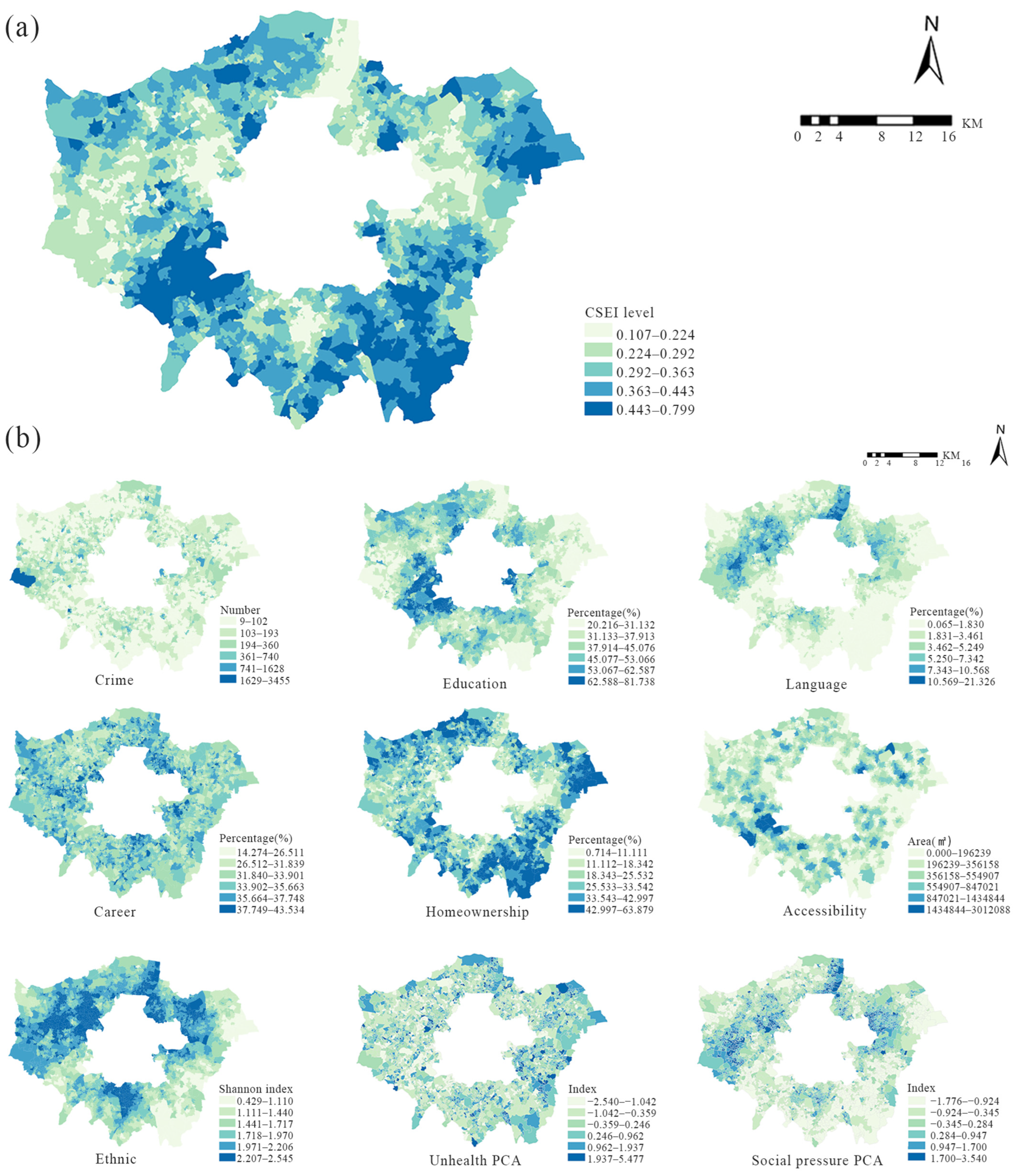
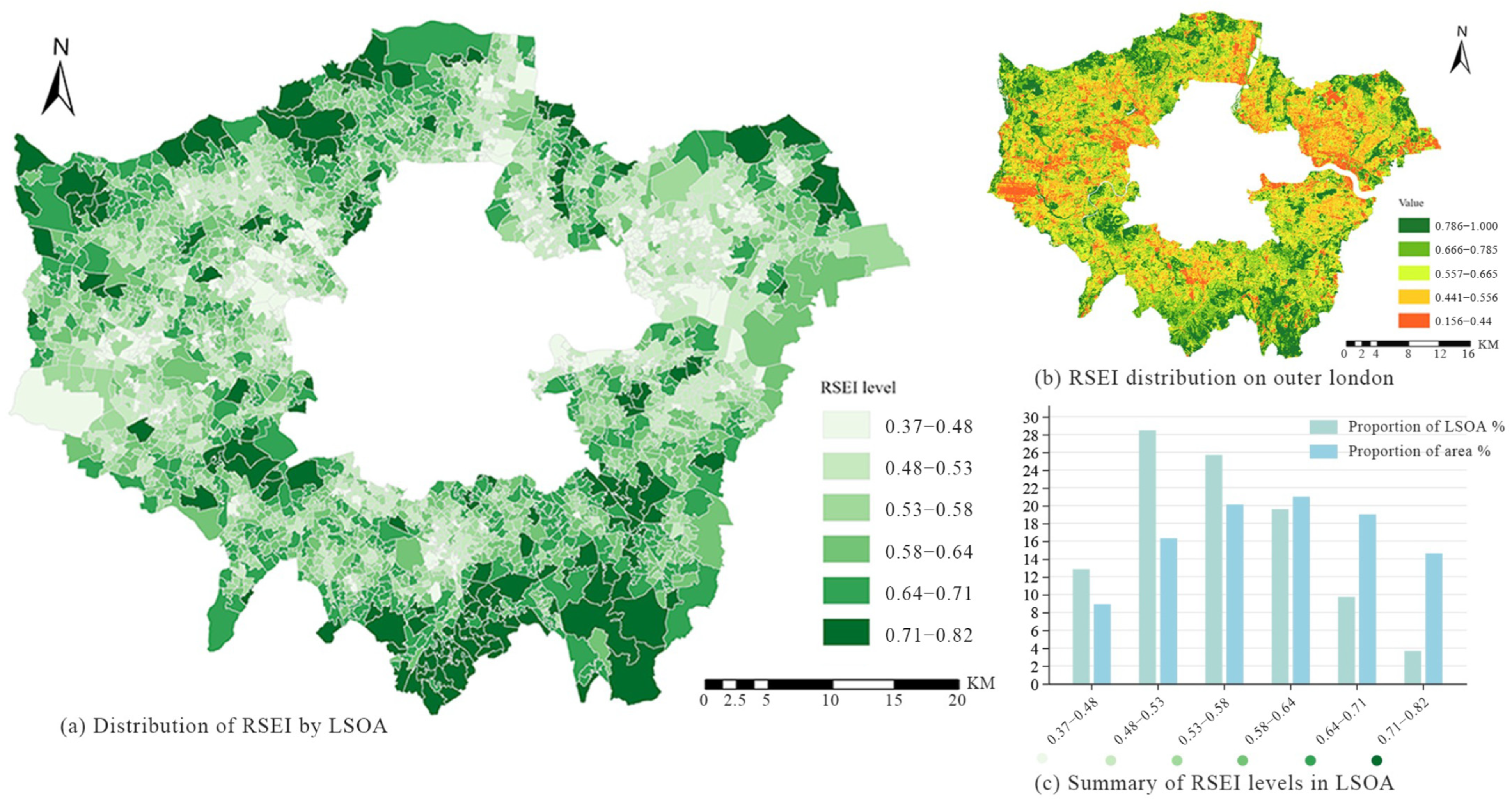
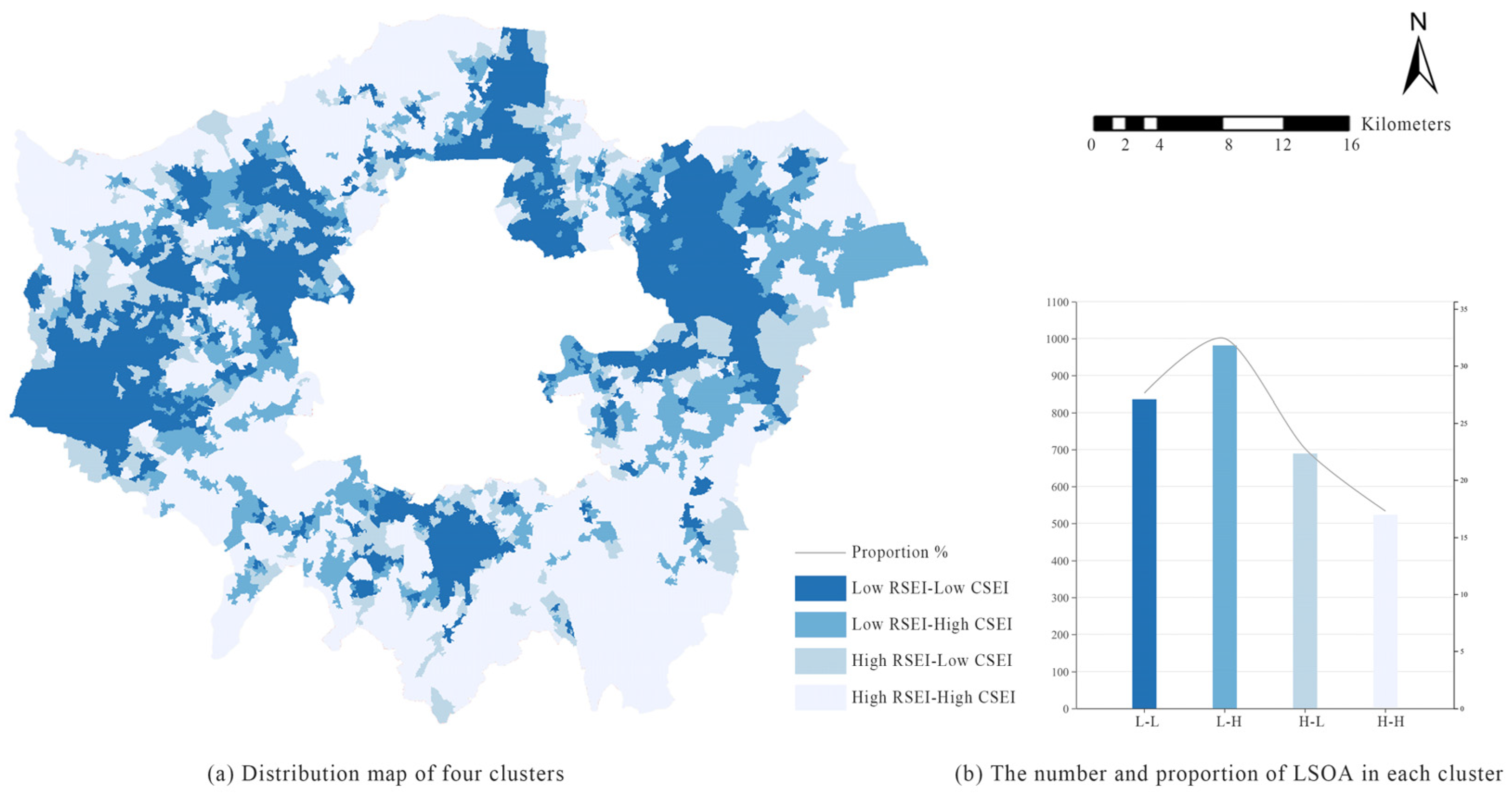
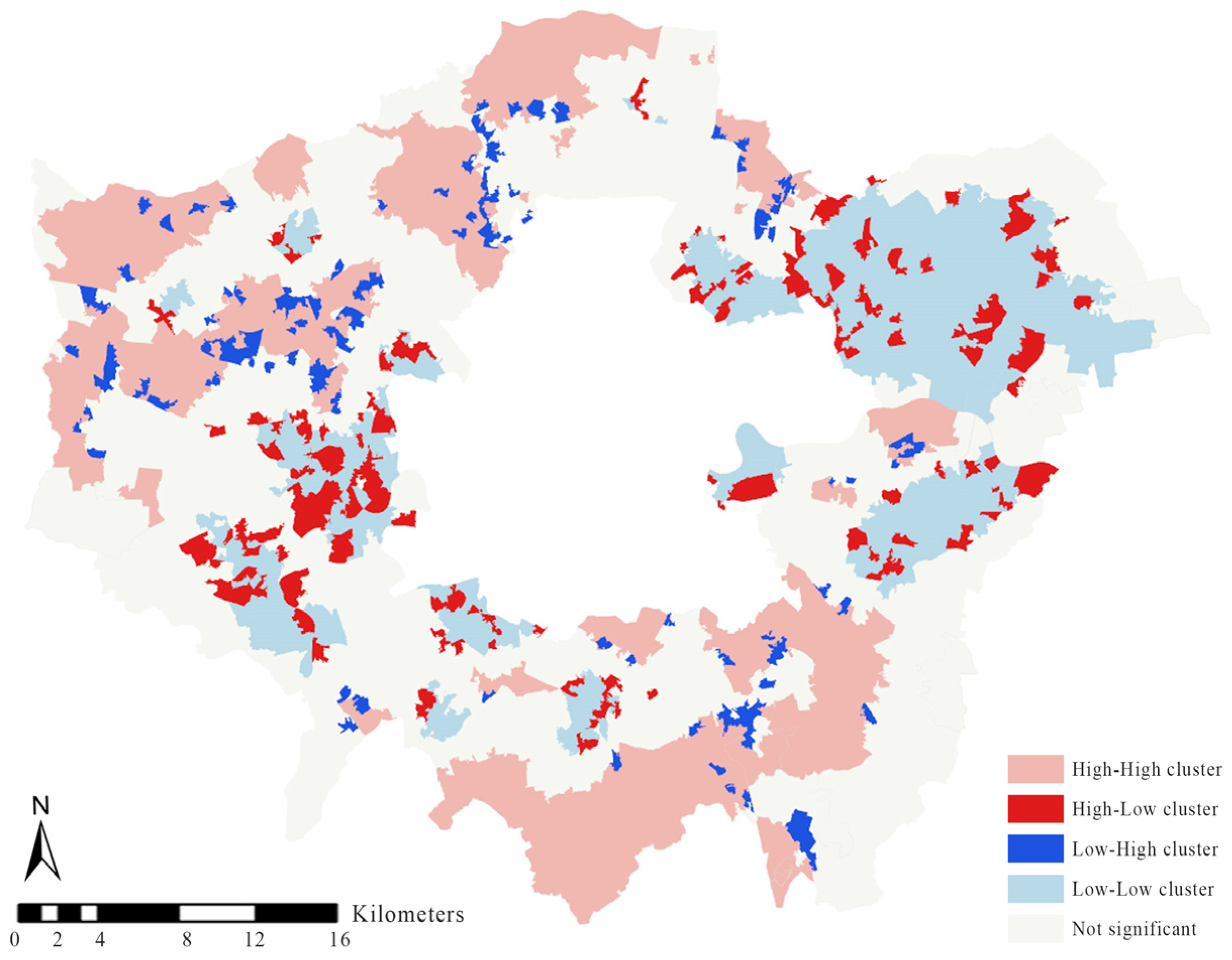
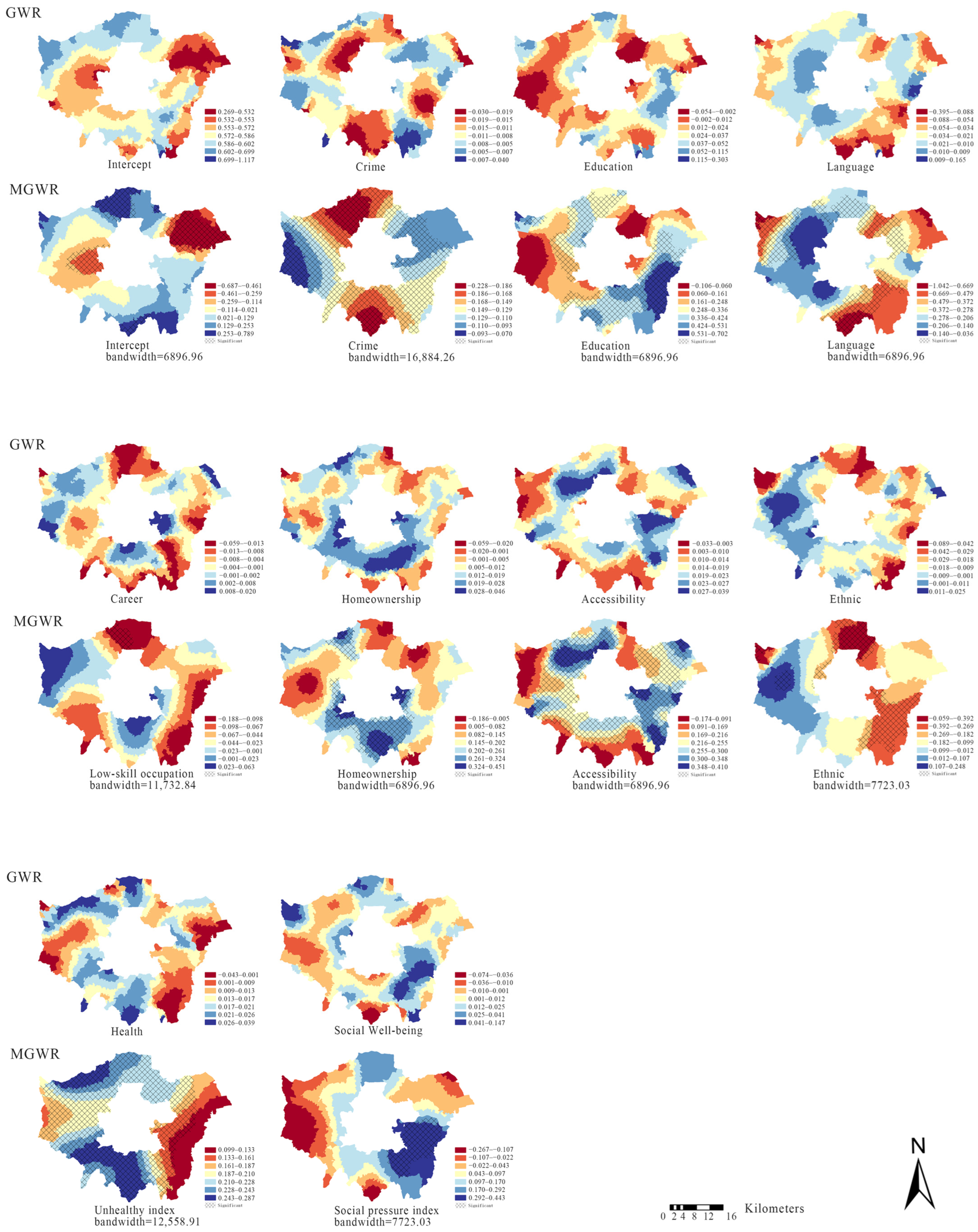
| Dimensions | Index | Description | Unit | Effect Direction | Weight |
|---|---|---|---|---|---|
| Career | Low-skill occupation rate | A proportion of the population engaged in lower occupations | % | Negative | 0.046 |
| Education, Skills | Tertiary education rate | Percentage of the population with tertiary education | % | Positive | 0.183 |
| Language barrier rate | The proportion of the population that cannot speak English and cannot speak English well | % | Negative | 0.020 | |
| Barriers to housing | Homeownership rate | Proportion of the population who own their house outright | % | Positive | 0.153 |
| Accessibility | Accessibility of green space | The total area of green Spaces that can be reached within a ten-minute walk | m2 | Positive | 0.291 |
| Ethnic | Ethnic diversity index | Using the Shannon index to measure ethnic diversity | Index | Negative | 0.228 |
| Crime | Total number of crimes | The sum of all crime types in an area | Number | Negative | 0.002 |
| Unhealthy index | Unhealthy-Disability PCA | An indicator synthesized from unhealthy rate and disability rate through PCA | Index | Negative | 0.022 |
| Social pressure index | Unemployment-Housing overcrowding PCA | An indicator synthesized from unemployment rate and housing overcrowding rate through PCA | Index | Negative | 0.055 |
| Variable | Coefficient | Probability | Robust-SE | VIF |
|---|---|---|---|---|
| Intercept | 0.573738 | 0.000000 * | 0.001081 | |
| Crime | −0.012526 | 0.000000 * | 0.001293 | 1.208083 |
| Education | 0.014839 | 0.000000 * | 0.001629 | 2.283365 |
| Language barrier rate | −0.020251 | 0.000000 * | 0.002016 | 3.257054 |
| Low-skill occupation rate | 0.000006 | 0.996096 | 0.001168 | 1.188187 |
| Homeownership rate | 0.019752 | 0.000000 * | 0.00198 | 3.092083 |
| Green space accessibility | 0.014922 | 0.000000 * | 0.001231 | 1.036814 |
| Ethnic diversity | −0.002888 | 0.085315 | 0.001705 | 2.367402 |
| Unhealthy index | 0.019839 | 0.000000 * | 0.001470 | 1.861663 |
| Social pressure index | −0.000943 | 0.724930 | 0.002704 | 6.129782 |
| Variable | MGWR | GWR | ||||||
|---|---|---|---|---|---|---|---|---|
| Min. | Max. | Mean | STD | Min. | Max. | Mean | STD | |
| Intercept | −0.6871 | 0.7893 | −0.0437 | 0.2451 | 0.2691 | 1.1172 | 0.5728 | 0.0276 |
| Crime | −0.2285 | −0.0708 | −0.1391 | 0.0343 | −0.0305 | 0.0406 | −0.0119 | 0.0065 |
| Education | −0.1066 | 0.7023 | 0.2762 | 0.1611 | −0.0548 | 0.3039 | 0.0209 | 0.0197 |
| Language | −1.0429 | −0.0370 | −0.2895 | 0.1627 | −0.3959 | 0.1657 | −0.0234 | 0.0199 |
| Low-skill occupation rate | −0.1882 | 0.0637 | −0.0360 | 0.0447 | −0.0593 | 0.0202 | −0.0029 | 0.0067 |
| Homeownership | −0.1865 | 0.4510 | 0.1692 | 0.1038 | −0.0597 | 0.0469 | 0.0123 | 0.0111 |
| Accessibility | −0.1748 | 0.4109 | 0.2483 | 0.0852 | −0.0340 | 1.000 | 0.0187 | 0.0076 |
| Ethnic | −0.5948 | 0.2489 | −0.1415 | 0.1683 | −0.0899 | 4.1499 | −0.0113 | 0.0162 |
| Unhealthy index | −0.0996 | 0.2879 | 0.2060 | 0.0399 | −0.0431 | 0.0391 | 0.0158 | 0.0068 |
| Social pressure index | −0.2673 | 0.4432 | 0.1005 | 0.1504 | −0.0741 | 0.1477 | 0.0089 | 0.0181 |
| Cluster | Key Variables | Coefficient | General Variables | Coefficient |
|---|---|---|---|---|
| Low RSEI-Low CSEI | Language | −0.280 | Homeownership | 0.165 |
| Education | 0.264 | Ethnic | −0.142 | |
| Accessibility | 0.253 | Crime | −0.135 | |
| Unhealthy | 0.206 | |||
| Low RSEI-High CSEI | Education | 0.269 | Homeownership | 0.173 |
| Language | −0.268 | Crime | −0.138 | |
| Accessibility | 0.251 | Ethnic | −0.129 | |
| Unhealthy | 0.209 | Social pressure | 0.101 | |
| High RSEI-Low CSEI | Language | −0.278 | Homeownership | 0.155 |
| Education | 0.263 | Crime | −0.145 | |
| Accessibility | 0.246 | Ethnic | −0.143 | |
| Unhealthy | 0.210 | |||
| High RSEI-High CSEI | Language | −0.359 | Unhealthy | 0.195 |
| Education | 0.326 | Homeownership | 0.188 | |
| Accessibility | 0.239 | Ethnic | −0.162 | |
| Crime | −0.139 | |||
| Social pressure | 0.130 |
| Cluster | Key Variables (Coef, Bandwidth) | Governance Scale | Governance Focus | Innovative Governance Strategies |
|---|---|---|---|---|
| Low RSEI-Low CSEI | Language (−0.280, 6896.96 m) Education (+0.264, 6896.96 m) Accessibility (+0.253, 6896.96 m) Unhealthy (0.206, 12,558.91 m) | Local + Borough | Social reinvestment and ecological restoration co-improvement |
|
| Low RSEI-High CSEI | Education (+0.269, 6896.96 m) Language (−0.268, 6896.96 m) Accessibility (+0.251, 6896.96 m) Unhealthy (+0.209, 12,558.91 m) | Local + Regional | Ecological restoration and green infrastructure renewal |
|
| High RSEI-Low CSEI | Language (−0.278, 6896.96 m) Education (+0.263, 6896.96 m) Accessibility (+0.246, 6896.96 m) Unhealthy (+0.210, 12,558.91 m) | Local + Borough | Social inclusion within ecologically rich settings |
|
| High RSEI-High CSEI | Language (−0.359, 6896.96 m) Education (+0.326, 6896.96 m) Accessibility (+0.239, 6896.96 m) | Local + Regional | Consolidate sustainability and cross-regional assistance |
Disclaimer/Publisher’s Note: The statements, opinions and data contained in all publications are solely those of the individual author(s) and contributor(s) and not of MDPI and/or the editor(s). MDPI and/or the editor(s) disclaim responsibility for any injury to people or property resulting from any ideas, methods, instructions or products referred to in the content. |
© 2025 by the authors. Licensee MDPI, Basel, Switzerland. This article is an open access article distributed under the terms and conditions of the Creative Commons Attribution (CC BY) license (https://creativecommons.org/licenses/by/4.0/).
Share and Cite
Mao, Q.; Chen, M. Unraveling Socio-Ecological Inequities in Outer London: Cluster-Based Resilience Planning. Land 2025, 14, 2303. https://doi.org/10.3390/land14122303
Mao Q, Chen M. Unraveling Socio-Ecological Inequities in Outer London: Cluster-Based Resilience Planning. Land. 2025; 14(12):2303. https://doi.org/10.3390/land14122303
Chicago/Turabian StyleMao, Qian, and Mingze Chen. 2025. "Unraveling Socio-Ecological Inequities in Outer London: Cluster-Based Resilience Planning" Land 14, no. 12: 2303. https://doi.org/10.3390/land14122303
APA StyleMao, Q., & Chen, M. (2025). Unraveling Socio-Ecological Inequities in Outer London: Cluster-Based Resilience Planning. Land, 14(12), 2303. https://doi.org/10.3390/land14122303







